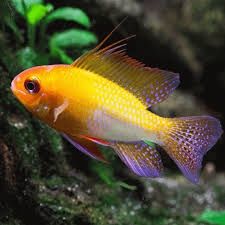Golden Ramirezi
The Golden Ram (Mikrogeophagus ramirezi), also known as the Golden Ram Cichlid, is a beautiful variation of the popular German Blue Ram. Known for its striking golden coloration with subtle shades of blue and yellow, the Golden Ram is a peaceful dwarf cichlid species that can thrive in community tanks if provided with the right care.
Here’s a complete Golden Ram Cichlid Care Guide:
Golden Ram Cichlid Care Guide
1. Tank Setup
-
Tank Size: Golden Rams are relatively small, so they can thrive in 20-gallon (75 liters) tanks or larger. A larger tank provides better water stability and more swimming space.
-
Aquascaping: Golden Rams appreciate a well-planted aquarium with lots of hiding spots. Live plants like Java Fern, Amazon Sword, Anubias, and Java Moss not only provide shelter but also help improve water quality.
-
Substrate: A soft substrate, such as fine gravel or sand, is ideal. Golden Rams like to dig and sift through the substrate, and soft sand won’t damage their delicate barbels.
-
Water Temperature: These tropical fish require warm water. Keep the temperature between 28°C and 30°C (82°F to 86°F). Consistent warm water is essential to their health.
-
Water pH: Golden Rams prefer slightly acidic to neutral water. Aim for a pH range of 6.0 to 7.0. Soft water is best, but they can tolerate slightly harder water if it is not too extreme.
-
Filtration: A gentle filter is recommended, as strong currents can stress the Golden Rams. A sponge filter or a low-flow hang-on-back filter will provide good filtration without disturbing them.
2. Diet
-
Omnivores: Golden Rams are omnivores and require a varied diet. Offer them high-quality flakes, pellets, and frozen foods such as brine shrimp, bloodworms, and daphnia.
-
Vegetation: They also benefit from occasional blanched vegetables like zucchini, spinach, or peas. This helps provide a balanced diet and supports their overall health.
-
Feeding Frequency: Feed them 2-3 small meals per day, ensuring they can consume everything within a few minutes to avoid overfeeding. Overfeeding can degrade water quality.
-
Avoid Overfeeding: Be cautious with portions, as Golden Rams are small fish and can easily become bloated if fed too much.
3. Tank Mates
-
Peaceful: Golden Rams are peaceful and generally non-aggressive, making them ideal for a community tank. They get along well with other peaceful species that don’t compete aggressively for food or space.
-
Compatible Tankmates:
-
Tetras (e.g., Neon Tetras, Cardinal Tetras, Rummynose Tetras)
-
Rasboras (e.g., Harlequin Rasboras, Celestial Pearl Danios)
-
Corydoras Catfish
-
Otocinclus Catfish (for algae control)
-
-
Avoid Aggressive Fish: Do not house Golden Rams with large or aggressive fish that might harass them, such as Cichlids, Barbs, or larger Livebearers.
-
Other Rams: You can keep multiple Golden Rams together, but it’s best to have a pair to minimize territorial aggression. Ensure there are plenty of hiding spots and decorations to reduce stress during breeding.
4. Behavior
-
Social and Peaceful: Golden Rams are peaceful and often swim in the middle to lower parts of the tank. They are social and enjoy the company of other peaceful fish, especially their own kind when kept in pairs or small groups.
-
Territorial During Breeding: While not generally aggressive, Golden Rams can become territorial when breeding. They will guard their spawning sites (usually flat surfaces such as rocks or plants) and may chase off other fish that get too close.
-
Active and Curious: These fish are active, inquisitive, and often interact with their environment. They enjoy exploring plants, decorations, and searching for food.
5. Water Quality & Maintenance
-
Water Quality: Golden Rams are sensitive to poor water conditions, so maintaining high water quality is key to keeping them healthy. Perform regular water changes (20-30% per week) to keep ammonia, nitrites, and nitrates at safe levels.
-
Ammonia and Nitrites: Both ammonia and nitrites must always be at 0 ppm. Golden Rams are more sensitive to poor water quality than many other fish, so it's important to keep the water pristine.
-
Nitrates: Keep nitrates below 20 ppm. Regular water changes and a good filtration system will help maintain low nitrate levels.
-
Stable Temperature: Maintaining a consistent water temperature between 28°C and 30°C (82°F to 86°F) is crucial for their health. Avoid temperature fluctuations that can cause stress.
6. Health & Common Issues
-
Stress: Stress is the primary cause of health problems in Golden Rams. Ensure stable water conditions, avoid aggressive tankmates, and minimize handling to reduce stress.
-
Common Illnesses: Golden Rams can be susceptible to Ich, Fin Rot, and Velvet if water quality is poor or if they are stressed. Regularly monitor their health for signs of illness, such as fading colors, clamped fins, or abnormal swimming behavior.
-
Molting: As a type of cichlid, Golden Rams don’t molt, but they may experience stress-related issues such as skin damage or fin rot if not properly cared for.
-
Skin and Coloration: Golden Rams are known for their vibrant colors. Fading color can indicate poor water conditions, stress, or an imbalanced diet. Healthy fish will maintain a bright golden yellow hue with subtle blue highlights.
7. Breeding
-
Breeding Setup: To breed Golden Rams, provide a stable and peaceful environment. Keep the water temperature slightly higher (around 30°C/86°F) and ensure good water quality. A well-planted tank with plenty of hiding spots is ideal.
-
Pairing: It’s best to purchase several juvenile Golden Rams and allow them to pair off naturally. Once a pair forms, they will become quite protective of their territory.
-
Spawning: Golden Rams lay their eggs on flat surfaces like leaves, rocks, or tank decorations. The female will guard the eggs, while the male fertilizes them.
-
Fry Care: After hatching, the fry will swim freely after about 3-4 days. The parents may help care for the fry, but you can feed them infusoria or baby brine shrimp to support their early growth.
-
Separating the Fry: If you wish to raise the fry, consider moving them to a separate tank with suitable filtration and food. The adult Rams may become protective, so it’s best to ensure their fry are safe.
8. Lighting and Aquascaping
-
Lighting: Moderate lighting works well for Golden Rams. Bright lighting can cause stress, but they also need enough light to feel secure. Using live plants with moderate lighting also helps maintain a healthy tank environment.
-
Planted Tank: Golden Rams thrive in planted tanks. Provide plenty of plants and decorations that offer both shelter and natural foraging opportunities. Plants like Java Fern, Amazon Sword, and Cryptocoryne are excellent options.
Final Thoughts:
The Golden Ram Cichlid is a beautiful and peaceful fish that can make a striking addition to a well-maintained community tank. With proper care, stable water parameters, and a balanced diet, these cichlids will thrive and display their vibrant golden hues. They’re not the easiest fish to care for, but they’re well worth the effort.

